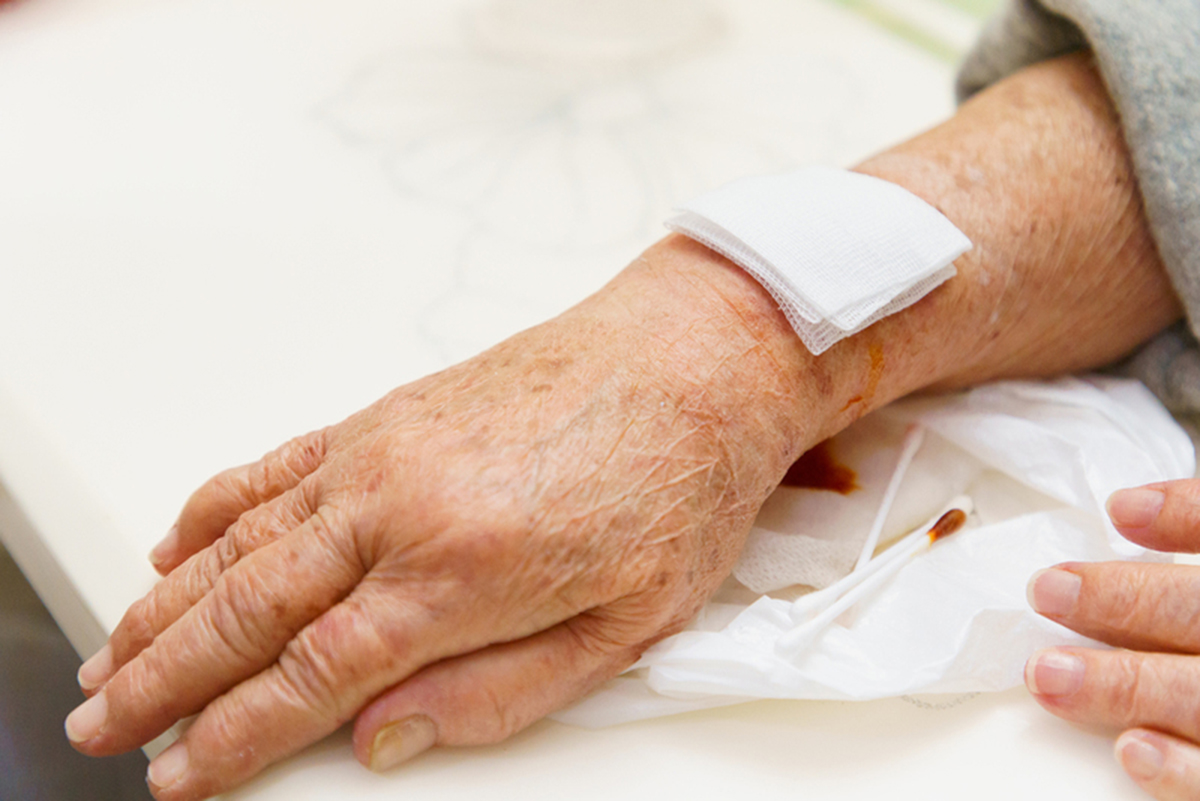Arthritis is a common disease that affects different joints of the body, often leading to joint pain, stiffness and swelling. One of the most common subtypes of arthritis is rheumatoid arthritis.

Rheumatoid arthritis develops due to autoimmunity, which is a process that causes the immune system – which normally functions to protect us foreign pathogens – starts to attack healthy tissue. Inflammation is a hallmark of autoimmunity, and high levels of inflammation throughout the body can lead to the development of other diseases that affect different organs including the heart, eyes, blood vessels and even the skin.
1. Large number of sores or purple spots
One inflammatory condition that has been shown to develop in patients with arthritis is known as vasculitis (inflammation of small blood vessels). This is often signaled by the development of many sores or purple spots on the skin. If these sores are present in the lower extremities (such as the toes), then it may be vasculitis. This can be especially dangerous as vasculitis can lead to organ damage. There are several subtypes of vasculitis, each of which affect a different kind of blood vessel. Thus, there are several different skin lesions that can develop in patients with vasculitis.
2. Colored lines seen from under the skin
Blood vessels that are dilated (widened) tend to emit the color red or purple. Thus, you may see thin red or purple lines in the skin. If these colors are present in the vessels of the face or in the vicinity of your nails, then it can be caused by different diseases including dermatomyositis or scleroderma. If you start to see the development of red lines or other skin symptoms, you should go see your doctor as treatment is most effective when its initiated early on.
3. Non-healing wounds
Patients with arthritis often take medications known as biologic drugs (i.e. TNF inhibitors). These biologics increase the risk of getting cancer, including skin cancer. In fact, one study found that people who use TNF inhibitors are at a 45 percent higher risk of developing skin cancers that are not melanoma. One of the major signs of skin cancer is when a wound on the skin doesn’t heal for a long time (for instance, a month). Additionally, the wound may also be painful, be infected or be bleeding. These are symptoms of skin cancer. Therefore, if you are an arthritis patient and are taking TNF inhibitors, then you should be on the lookout for these signs of skin cancer.
4. Strange bruises
Arthritis patients often take corticosteroids as a treatment for their condition. Corticosteroids are drugs that help suppress the immune system, which helps lower inflammation. Unfortunately, patients with corticosteroids can often experience bruising that is unusual. For example, patients may develop large bruises and not know where they came from or a previously small bruise becomes larger. If that is the case, then make sure to go see your doctor because your body may not be able to heal itself properly, which can be very damaging in the long term.
5. Discolored extremities
Patients with autoimmune disease, such as rheumatoid arthritis, are at a higher risk for developing other autoimmune diseases such as Raynaud’s disease. In patients with Raynaud’s disease, the immune system attacks the blood vessels that supply blood to the fingers and toes, causing the blood vessels to narrow. This leads the fingers or the toes to obtain a bluish look, particularly when the patient is cold or feeling stressed.
6. Higher sensitivity to the sun
People that take certain types of drugs, including medications such as non-steroidal anti-inflammatory drugs (NSAIDs), methotrexate, certain types of antibiotics and antidepressants, develop sensitivity to the sun. Another disease in which patients are more sensitive to the sun is the autoimmune disease lupus. Symptoms of photosensitivity (sensitivity to the sun) include burning in the sun more easily that you previously did, or developing rashes or hives faster than you have previously have. Essentially, if you notice any changes in how, where and the pattern in which you burn in the sun, make sure to make an appointment to see your doctor as that could signal an underlying condition that needs to be treated.
Conclusion
There are several different manners in which having arthritis can affect our skin or cause skin disease. It is important to be vigilant and to do weekly checks of your skin to see if you have any new bruises and see any discoloration.
- Chakravarty, Eliza F., Kaleb Michaud, and Frederick Wolfe. "Skin cancer, rheumatoid arthritis, and tumor necrosis factor inhibitors." The Journal of Rheumatology 32.11 (2005): 2130-2135.
- Amari, Wassila, et al. "Risk of non-melanoma skin cancer in a national cohort of veterans with rheumatoid arthritis." Rheumatology 50.8 (2011): 1431-1439.
- Jones, S. M., et al. "Psoriatic arthritis: outcome of disease subsets and relationship of joint disease to nail and skin disease." Rheumatology 33.9 (1994): 834-839.
- Photo courtesy of SteadyHealth


Your thoughts on this